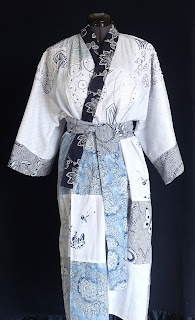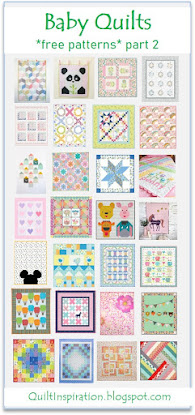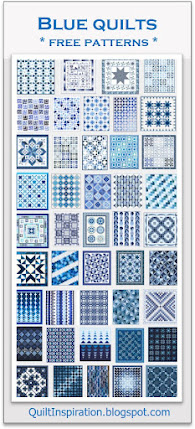Sampler Cubed, 69 x 37”, by Nancy Colladay (Kinsington, Maryland)
Nancy Colladay's original design, entered in the Mid Century Mod quilt competition, was machine pieced and longarm quilted. She says, "The work of Victor Vasarely, particularly in the 1970s and 1980s, is very geometric and appears three-dimensional. As a quilter his pieces remind me of the tumbling block layout. By using traditional blocks inside the tumbling blocks, I tried to bring tradition into the realm of modern quilting." We enjoyed the precise Greek key quilting design in the negative space.
Nancy continues, "While the colors I selected are somewhat calmer than the mid-century modern artist’s palette, light blue and chocolate brown were very fashionable in the 1960’s and I find them pleasing." A subtle variation in values creates a three-dimensional look.
Child, 68 x 85”, by Junko Isawa (Japan)
Child was exhibited in the World Quilt Competition at the 2016 PIQF show. Each face of each tumbling block is comprised of a quilt block design such as a pinwheel or square-within-square. Hand stitching and quilting such small pieces with kimono silk is not easy, and Junko Isawa did a masterful job. She says, "I have been collecting pretty fabrics for a long time. This work, in celebration of children, was made from children’s kimono fabrics that were from my collection."
Junko says that she began by classifying all her fabrics into three categories based on their brightness [value]. She says that this quilt was difficult to make and it took some time to complete!
This Way or That by Ruth Archer (South Africa)
This quilt is distinguished by its use of shimmering color, created by subtle variations in pattern and hue arranged to create a waterfall effect. It is hand pieced and hand quilted. Ruth Archer says that this started out as a cushion cover, created out of boredom while she was on holiday in Australia. It grew and developed as she went along without any plan except for a love of the colors.
The name of the quilt, "This Way or That", comes from the fact that the quilt can be viewed from both sides! She added short strings of beads to embellish the bottom edge of the quilt.
Tumbling Tornado by Claire Victor (Palm Springs, California)
Claire Victor created this variation of a tumbling blocks and stars design. We love the bright analogous color scheme, the arrangement of the blocks, and the unique border. Claire says, "I modified a pattern by Marci Baker and added my original border to this tumbling block design. It was extremely challenging because of the size and the fact that the light source constantly changes."
Out of the Mist, 39 x 46”, by Kim Loar (Lancaster, PA)
Out of the Mist is a perfect example of the use of three values (dark, medium and light) to create the tumbling blocks illusion. It won a blue ribbon for Best Machine Quilting in the 12th Annual Quilters Treasure challenge. Kim Loar says, "Out of the Mist represents my passion for geometric pattern and my love of watching the sun peek through on a misty morning. The grays represent the mist/clouds with the different reds as the sun."
The quilt was based on the Butterflies quilt pattern in Gyleen Fitzgerald’s book, Polygon Affair. Using Gyleen’s method, this quilt was mostly constructed using Y-seams, a technique that Kim Loar wanted to master.
Optical Cubes by Jeanne Walsh (Tucson, Arizona)
In June 2012, Jeanne Walsh (who was, at the time, a beginning quilter) took a class from Karen Combs on an Alaska quilting cruise. For this project she used Karen’s “Patchwork Illusions” pattern. A geometric focus fabric was used to create the ribbons on the “packages”.
Life = Opposites, 43 x 43", by Shoshi Finkelstein (Israel)
Shoshi Finkelstein used black, white and red music-themed fabric to create interest in this dramatic version of a honeycomb design. In the close-up photo below you can see that the top of each cube is made from two 60-degree triangles instead of a single diamond; this "quick" method of tumbling block construction avoids the need for inset or Y-seams. The quick method was described in detail Sara Nephew's classic 2001 book, the Big Book of Building Block Quilts.
Cubicles, 44 x 50”, by Edwina J. Ow (San Francisco, California)
This honeycomb design looks totally different when each hexagon is made with a single color. Edwina Ow used dotted prints in a variety of hues to create a modern look. She says, "Twenty-five years ago I started traveling with my mother to Europe and Asia, working and knitting. Now I’m caring for my mother and grandsons, exercising, and quilting during my free time. This quilt is embellished with covered buttons purchased from the 80’s and Swarovski beads." Cubicles was machine piece and sewing machine quilted.
The Giant Tumble by Diana McClun and Laura Nownes; quilted by Marla Monson
Here's the easiest of all tumbling block quilts! Comprised of only 27 pieces, plus border triangles, The Giant Tumble couldn't be simpler. It is featured on page 62 of the book Quilts! Quilts!! Quilts!!! by Diana McClun and Laura Nownes. This quilt shows that print fabrics can be used to create tumbling blocks as long as the light-medium-dark value principle is maintained. Laura also gives workshops on foolproof Y-seam construction.
Image credits: Photos were taken by Quilt Inspiration at the 2016 Pacific International Quilt Festival, the 2014 Road to California (The Giant Tumble, Tumbling Tornado) and the 2014 Tucson Quilt Guild show (Optical Cubes).






























Wow, wow, wow! These are all wonderful!!! Thanks for sharing!
ReplyDeleteVery interesting and inspiring :)
ReplyDeleteI like the post that feature one block - wow, what diversity and creativeness.
ReplyDeleteSuch beautiful work!
ReplyDeleteTumbling blocks have always fascinated me. I started one using EPP, but the colors just weren't working.
ReplyDeleteI feel like I have just been to a geometry class. If all my math classes were like this, I might have enjoyed them more.
ReplyDeleteYour quilts design looks really awesome!
ReplyDelete